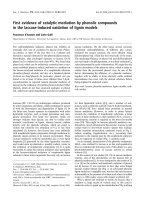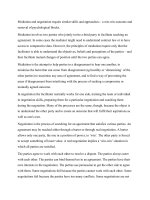Mediation
Bạn đang xem bản rút gọn của tài liệu. Xem và tải ngay bản đầy đủ của tài liệu tại đây (3.56 MB, 182 trang )
Mediation
Concepts to Conceive 21st Century Society Set
coordinated by
Valérie Larroche and Olivier Dupont
Volume 1
Mediation
A Concept for Information and
Communication Sciences
Jacqueline Deschamps
First published 2019 in Great Britain and the United States by ISTE Ltd and John Wiley & Sons, Inc.
Apart from any fair dealing for the purposes of research or private study, or criticism or review, as
permitted under the Copyright, Designs and Patents Act 1988, this publication may only be reproduced,
stored or transmitted, in any form or by any means, with the prior permission in writing of the publishers,
or in the case of reprographic reproduction in accordance with the terms and licenses issued by the
CLA. Enquiries concerning reproduction outside these terms should be sent to the publishers at the
undermentioned address:
ISTE Ltd
27-37 St George’s Road
London SW19 4EU
UK
John Wiley & Sons, Inc.
111 River Street
Hoboken, NJ 07030
USA
www.iste.co.uk
www.wiley.com
© ISTE Ltd 2019
The rights of Jacqueline Deschamps to be identified as the author of this work have been asserted by her
in accordance with the Copyright, Designs and Patents Act 1988.
Library of Congress Control Number: 2018962335
British Library Cataloguing-in-Publication Data
A CIP record for this book is available from the British Library
ISBN 978-1-78630-386-8
Contents
Preface . . . . . . . . . . . . . . . . . . . . . . . . . . . . . . . . . . . . .
ix
Introduction . . . . . . . . . . . . . . . . . . . . . . . . . . . . . . . . . .
xiii
Part 1. Epistemological Foundations . . . . . . . . . . . . . . . . .
1
Introduction to Part 1 . . . . . . . . . . . . . . . . . . . . . . . . . . .
3
Chapter 1. Exploring the Concept . . . . . . . . . . . . . . . . . . .
5
1.1. A conceptual approach .
1.2. The origins . . . . . . . . .
1.3. Professional mediation .
1.4. Mediation and peace . .
.
.
.
.
.
.
.
.
.
.
.
.
.
.
.
.
.
.
.
.
.
.
.
.
.
.
.
.
.
.
.
.
.
.
.
.
.
.
.
.
.
.
.
.
.
.
.
.
.
.
.
.
.
.
.
.
.
.
.
.
6
8
10
13
Chapter 2. The Constituent Elements of Mediation . . . . . . .
17
2.1. The third party . . . . . . . . . . . . . . . . . . . .
2.1.1. From the word to the concept . . . . . . . .
2.1.2. Models and functions of the third party .
2.1.3. The power and authority of a third party
2.1.4. The symbolic third party . . . . . . . . . . .
2.2. Relation. . . . . . . . . . . . . . . . . . . . . . . . .
2.2.1. A concept present in numerous fields . . .
2.2.2. Relation as a process. . . . . . . . . . . . . .
2.2.3. Interactivity . . . . . . . . . . . . . . . . . . .
2.2.4. The socioeconomics of relation . . . . . . .
.
.
.
.
.
.
.
.
.
.
.
.
.
.
.
.
.
.
.
.
.
.
.
.
.
.
.
.
.
.
.
.
.
.
.
.
.
.
.
.
.
.
.
.
.
.
.
.
.
.
.
.
.
.
.
.
.
.
.
.
.
.
.
.
.
.
.
.
.
.
.
.
.
.
.
.
.
.
.
.
.
.
.
.
.
.
.
.
.
.
.
.
.
.
17
18
19
22
24
26
27
28
32
35
vi
Mediation
2.3. The subject . . . . . . . . . . . . . . .
2.3.1. The subject in philosophy . . .
2.3.2. The subject in psychoanalysis
2.3.3. The subject in mediation . . . .
.
.
.
.
.
.
.
.
.
.
.
.
.
.
.
.
.
.
.
.
.
.
.
.
.
.
.
.
.
.
.
.
.
.
.
.
37
37
41
43
Chapter 3. The Organization of Mediations . . . . . . . . . . . .
45
3.1. Mediation and institution . . . . . . . . . . . . .
3.1.1. The spirit of institution . . . . . . . . . . . .
3.1.2. A historical approach to institutions . . . .
3.1.3. The human and the institutional spheres
3.1.4. Parliamentary mediation . . . . . . . . . . .
3.2. Dispositive and mediation . . . . . . . . . . . . .
3.2.1. Dispositives in mediation . . . . . . . . . . .
3.2.2. The social dispositive . . . . . . . . . . . . . .
3.2.3. Technological dispositives . . . . . . . . . . .
3.2.4. Legitimizing a dispositive . . . . . . . . . . .
.
.
.
.
.
.
.
.
.
.
.
.
.
.
.
.
.
.
Chapter 4. Time and Mediation. . . . . . . . . . . . . . . . . . . . .
57
57
59
61
64
Part 2. Mobilizing the Concept of Mediation in
Information and Communication Sciences . . . . . . . . . . . .
67
Introduction to Part 2 . . . . . . . . . . . . . . . . . . . . . . . . . . .
69
Chapter 5. Communicational Mediations . . . . . . . . . . . . . .
73
.
.
.
.
.
.
.
.
.
.
.
.
.
.
.
.
.
.
.
.
.
.
.
.
.
.
.
.
.
.
.
.
.
.
.
.
.
.
.
.
.
.
.
.
.
.
.
.
.
.
.
.
.
.
5.1. Transmitting and accessing knowledge .
5.2. Scientific communication . . . . . . . . . . .
5.3. Digital mediations . . . . . . . . . . . . . . .
5.3.1. Information accessibility . . . . . . . . .
5.3.2. The digital mediation of our heritage
5.3.3. The digital mediation of libraries . . .
.
.
.
.
.
.
.
.
.
.
.
.
.
.
.
.
.
.
45
46
46
49
50
52
52
53
54
55
.
.
.
.
.
.
.
.
.
.
.
.
.
.
.
.
.
.
.
.
.
.
.
.
.
.
.
.
4.1. The time of mediations . . . . . . . . . . . . . . . .
4.1.1. Synchronous and asynchronous mediations
4.1.2. Diachronic mediation . . . . . . . . . . . . . . .
4.2. Timeless mediation . . . . . . . . . . . . . . . . . . .
.
.
.
.
.
.
.
.
.
.
.
.
.
.
.
.
.
.
.
.
.
.
.
.
.
.
.
.
.
.
.
.
.
.
.
.
75
78
82
82
85
87
Contents
Chapter 6. Informational Mediations . . . . . . . . . . . . . . . . .
6.1. Information professionals . . . . . . . . . .
6.2. Documentary mediation in academia . .
6.3. Competitive intelligence and mediation
6.4. Strategic foresight and mediation . . . .
.
.
.
.
.
.
.
.
.
.
.
.
.
.
.
.
.
.
.
.
.
.
.
.
.
.
.
.
.
.
.
.
.
.
.
.
.
.
.
.
vii
89
89
93
95
97
Chapter 7. Cultural Mediations . . . . . . . . . . . . . . . . . . . . . 101
7.1. Mediation and cultural institutions . . . . . . . . . . . . . 102
7.2. Promoting our heritage . . . . . . . . . . . . . . . . . . . . . 106
7.3. Artistic mediation . . . . . . . . . . . . . . . . . . . . . . . . . 108
Chapter 8. Organizational Mediations . . . . . . . . . . . . . . . . 111
8.1. Organizational theories . . . . . . . . . . . . . . . . . . . . . 112
8.2. Organizations and communication . . . . . . . . . . . . . . 116
8.3. Other perspectives in organizational communication . . 118
Chapter 9. Societal Mediations . . . . . . . . . . . . . . . . . . . . . 121
9.1. Political mediation and the public space . . . . . . . . . . 122
9.2. Public communication and citizenship . . . . . . . . . . . 127
9.3. Ecological mediation . . . . . . . . . . . . . . . . . . . . . . . 128
Conclusion . . . . . . . . . . . . . . . . . . . . . . . . . . . . . . . . . . 133
References . . . . . . . . . . . . . . . . . . . . . . . . . . . . . . . . . . 139
Index of Cited Authors . . . . . . . . . . . . . . . . . . . . . . . . . . 153
Index of Terms . . . . . . . . . . . . . . . . . . . . . . . . . . . . . . . . 157
Preface
The set “Concepts to Conceive 21st Century Society” is a
state of the art study of the latest theoretical developments
by researchers in Information and Communication Sciences
(ICS)1. The authors of the set have put forward an interplay
of concepts employed in the ICS community. These concepts
are also used in other disciplines related to the humanities
and social sciences (history, sociology, economics, linguistics,
psychology, etc.) and, in addition, often fitting in line with
the concerns of science and technology researchers
(ergonomics, AI, data analysis, etc.).
In this set, we aim to highlight the theoretical approaches
used in ICS, which is often regarded as a cross-disciplinary
field from a deliberately conceptual point of view. We
thought that this was the right choice to supplement the
different epistemological works that have already been
carried out in the field.
To describe more in detail the perspective adopted in each
of these works, we should point out that it represents the
point of view of researchers in ICS with a didactic aim and
1 In French, the two fields “Communication science” and “Information
science” belong to the same academic discipline, namely “Sciences de
l’information et de la communication (SIC)”.
x
Mediation
an epistemological focus. We will start by considering ICS as
an academic discipline that contributes to the creation and
dissemination of knowledge related to information and
communication.
Thus, our theoretical reflection will be based on the
analysis of a series of concepts widely used by the ICS
community, and we will aim to make it accessible to
humanities and social sciences students, as well as useful for
teachers and researchers in several fields, and for
professionals who wish to consider their practices. This
interplay of concepts allows us to conceive 21st-Century
society in its social and technological aspects. It also helps
shed light on human and technological relations and
interactions.
So far, this set of books is expected to include a dozen
works, each of which presents one of the following concepts,
which are widely used in ICS: power, discourse, mediation,
dispositive [dispositif], memory and transmission, belief,
knowledge, exchange, public/private, representation, writing
and aesthetics.
Each work in this set shares the same structure. A first
part, called “Epistemological Foundations”, summarizes and
allows us to compare the theories that over time have made
it possible to review the concept in question.
A second part, called “Mobilizing the Concept of Mediation
in Information and Communication Sciences”, presents
recent problems in ICS which involve the concept, with the
aim of establishing the topic researched or analyzing it. This
organization of the content allows us to get rid of the
restrictive meanings that concepts may take on in the public
or professional sphere, or even in various disciplines.
The first four works examine, in turn, the concepts of
power, discourse, mediation and the dispositive. Therefore,
Preface
xi
we can find in these first texts two concepts with a
substantial historical dimension, i.e. power and discourse,
and two other concepts that have emerged in recent history,
i.e. mediation and the dispositive.
These works result from a collective reflection. Regular
meetings among the different authors have made it possible
to write the four texts collaboratively, even if each author
takes responsibility for the work he or she has signed. The
content of these works also constitutes the foundations of a
course in ICS epistemology that has been offered in several
types of education for the past 10 years or so. Thus, it has
been tested before an audience of students of different levels.
Some authors have already been asked to write about the
other concepts. The series coordinators will ensure that these
authors follow the logic of the set and the structure of the
first four works.
Acknowledgments
I would like to thank Valérie Larroche, Olivier Dupont
and Jean-Paul Metzger, who have made it possible to write
this work. Thank you for your trust and involvement, as well
as the wealth of our exchanges. Even if I take full
responsibility for this text, I regard you as co-authors.
I would also like to thank the proofreaders of my
manuscript for their apposite remarks.
Jacqueline DESCHAMPS
November 2018
Introduction
To respect the logic of the series “Concepts to Conceive
21st Century Society”, this work is divided into two separate
parts. The first is dedicated to the epistemological
foundations of mediation. It clarifies the concept of
mediation, independently of the disciplines in which the
concept is used, by comparing the theories that over time
have made it possible to establish and then reassess it.
The second part is based on the present-day issues in
Information and Communication Sciences (ICS) that involve
the concept of mediation, with the aim of establishing the
topics to be researched and analyzing them.
As a concept employed in different fields, mediation is a
very old practice that is re-emerging today to meet the needs
of the modern world, and whose conceptualization, which is
overall recent, is taking root. Mediation is a practice that
involves two parties, who are sometimes very different, and
a third party who helps them come to an agreement. The
relation between them may be conflictual or not, and the
third party’s power depends only on the authority granted by
these two parties.
In the first part of this work, following the analysis of the
concept of mediation per se, its origins, mediation in its
professional dimensions and the relations of mediation and
xiv
Mediation
peace, the presentation of the epistemological foundations of
mediation is organized into three chapters:
– we approach the specific criteria that make mediation
coherent, independently of the sectors in which it will be
implemented. Several elements come into play, among which
is a third party involved in a mediating relationship between
subjects;
– institutions are also mediating tools. In a mediation
process, when individuals require arbitration, they are often
dealing with an institution. This is when the human and the
institutional dimension become involved in a common
dispositive;
– among the constants of mediation, time plays a
significant part and entails a spatiotemporal framework,
since mediation creates a before and an after between
absence and presence, and the issues concerning the
transformation process are part of this space time.
In the second part of this work, we investigate the way in
which researchers in ICS conceive the different approaches
to the concept. Mediation cannot be reduced to the resolution
of conflicts; instead, it is part of a replacement and
construction process, and this is how ICS see this concept.
This part is structured around five points:
– communicational mediations address the issues related
to accessing knowledge, whether through scientific
communication or digital mediations;
– among
informational
mediations,
documentary
mediation is widely cited by researchers. This mediation is
conceived as an empirical and theoretical space that can
shed light on several aspects of mediations. Mediation will
clarify the discussion about the two fields that it is supposed
to relate: information and public. Mediation denotes the acts
that allow a reader to come across a pre-existing document,
Introduction
xv
but it also refers to the mutual adaptations of supply and
demand;
– cultural mediations, as well as focus on the issue of the
role of the public and cultural democratization, are becoming
more and more relevant for researchers and practitioners;
– political mediation and public communication are being
researched in the field of societal mediations;
– environmental mediation is a type of mediation that
concerns the management, implementation of actions or
prevention of conflicts in the environmental or sustainable
development field.
The concept of mediation belongs to a field of research
that is firmly at the center of ICS, but it also simultaneously
brings together researchers from other fields. If the issue of
mediation returns insistently to the center of present-day
debates, it is probably because it expresses our need to deal
in a new way with the questions related to the psyche,
culture and our environment.
PART 1
Epistemological Foundations
Introduction to Part 1
“When, in a thousand years’ time, in the year
3000, historians study the end of the twentieth
century and the year 2000, when the
supercomputers they rely on, which can carry out
calculations down to the last zero, scan all the
texts of our period, from big books to the last
magazine or newspaper, they will undoubtedly
find that a word has taken over in particular the
last ten years of our life. A word that is made to
fit every occasion, which became magical before
our very eyes: mediation” (Six and Mussaud 2002,
p. 13).
A flourishing concept of mediation has become a
fashionable phenomenon, which is cited in several fields. It
even seems a sort of panacea that can solve conflicts of all
kinds and on every level (family, society, international, etc.).
Mediation, which is generally reduced to a technique,
represents first of all the emergence of a new course of action
that governs the relationships between individuals, but also,
and more generally, the relationships between the state and
civil society.
However, we quite often use the term of mediation
without properly considering its stakes and foundations.
Mediation: A Concept for Information and Communication Sciences,
First Edition. Jacqueline Deschamps.
© ISTE Ltd 2019. Published by ISTE Ltd and John Wiley & Sons, Inc.
4
Mediation
Mediation is not a vague notion, and it benefits from a
rigorous definition, but it suffers from a use that is too lax.
Thus, we will see in the first part of this work that the
concept of mediation relies on specific elements that deserve
specific attention.
1
Exploring the Concept
A flourishing concept of mediation has become a
fashionable phenomenon, which is cited in several fields.
However, we quite often use the term mediation without
properly considering its stakes and foundations. Mediation is
not a vague notion; it benefits from a rigorous definition, but
it suffers from a sometimes lax use. Generally, mediation can
be defined first of all as a way of building and managing
social life through an intermediary third party, who is
neutral, independent and has no other power than the
authority granted to them by the mediated individuals, who
will have freely chosen or recognized them (GuillaumeHofnung 1995).1
The main goal of mediation is the re-establishment or the
establishment of communication. We can say, in the words of
Michèle Guillaume-Hofnung, that mediation is basically
tripartite in its structure and result (Guillaume-Hofnung
1995).
There are multiple symbolic forms and mediations that
allow humans to establish relations with other individuals.
1 A substantial bibliography divided into basic references and more specific
texts will allow readers to find their way in the literature and supplement
the sometimes brief information contained in this work.
Mediation: A Concept for Information and Communication Sciences,
First Edition. Jacqueline Deschamps.
© ISTE Ltd 2019. Published by ISTE Ltd and John Wiley & Sons, Inc.
6
Mediation
Any intermediary is a mediator, even if often it is not
recognized as such: our body and language are mediators of
the world, a habit or speech are mediators, etc. According to
the type of mediation, the components will have different
shapes, from the singular to the collective and from objects to
the virtual dimension, including the human sphere.
Contemporary mediation relies on an external third party,
otherwise we refer to conciliation. “Mediation is conceived
both as the symptom of a societal evolution and as a remedy
to its diseases; it is simultaneously a theoretical perspective
and a course of action, a way of saying and a way of doing;
finally, it refers to both ‘micro’ (relation between an audience
and a work, relation between individuals in conflict) and
‘macro’ phenomena (relation between cultural groups or
worlds of meaning). We can already see that this topic
cannot be understood all at once.” (Servais 2016, p. 9). This
argument, put forward by Christine Servais, reflects
accurately the current use of the concept of mediation. This
concept, which has been employed in Information and
Communication Sciences since the 1990s, ranks among the
indispensable foundations of this field. For Jean Caune,
mediation is an essential concept that makes it possible to
describe and understand the relations among humans and
the relations between humans and the groups that they
create (Thonon 2003).
1.1. A conceptual approach
We have deliberately chosen a conceptual approach,
ruling out in particular a diachronic approach that would
juxtapose topics to be researched and their related
theoretical frameworks.
Concepts are useful tools for building theories or models
and constitute a way of offering a scientific overview of the
field. We distinguish between topics to be researched and
concepts, as the former pivot on practices, phenomena and
Exploring the Concept
7
human or social products, whereas concepts combine,
intensify and can be reused to understand these different
topics.
Concepts allow us to describe and understand the topics of
our research and the phenomena that characterize them. A
concept is an abstract and general idea (Cuvillier 1967).
André Comte-Sponville claims that a notion is generally
vaguer or broader, whereas a concept is narrower or more
precise. A notion can only be understood in context, while a
concept is somewhat autonomous; it is understood in a
theoretical context, but it can be abstracted and show a form
of self-sufficiency (Comte-Sponville 2001). While a notion
concerns common ways of thinking, a concept has to do with
a specific science or school of thought. Certainly, there are
different levels at which the idea of a concept can be grasped.
Naming facts and phenomena already constitute a
conceptual vision that defines terms, which correspond to the
typifications mentioned by Berger and Luckmann (1966).2
However, beyond naming, we can explain, understand and
abstract, and it is on this level that we should grasp the idea
of a concept such as it is employed in this work. In relation to
the concept of mediation, we will have to mention, sometimes
rapidly, a certain number of elements that allow us to specify
the way in which it is understood (among other things,
the idea of third party, relation, subject, institution,
organization, device, time in mediation, etc.). The references
employed in this work will enable the readers themselves to
delve deeper into those elements that according to them have
been addressed too cursorily.
2 When we refer to old publications, we provide in the text and as far as
possible the date of the original edition; in the bibliography, we specify the
date of the edition consulted.









